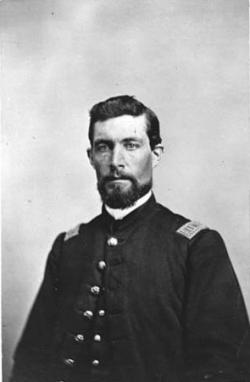 Timothy J. Sheehan as born in Ireland in 1836. He was 14 years old when he came to the US. He was a mechanic in New York until 1855, and worked at a sawmill in Illinois. By 1856, he lived in Albert Lea, Minnesota, where he was a farmer. At the time of the Civil War, he enlisted in the army, and became a Corporal in Company F, 4th Minnesota Infantry in 1861. He was promoted to First Lieutenant in Company C, 5th Minnesota Infantry on March 9, 1862.
Timothy J. Sheehan as born in Ireland in 1836. He was 14 years old when he came to the US. He was a mechanic in New York until 1855, and worked at a sawmill in Illinois. By 1856, he lived in Albert Lea, Minnesota, where he was a farmer. At the time of the Civil War, he enlisted in the army, and became a Corporal in Company F, 4th Minnesota Infantry in 1861. He was promoted to First Lieutenant in Company C, 5th Minnesota Infantry on March 9, 1862.
Company C began garrison duty at Fort Ripley and Sheehan was then sent to Fort Ridgely, along with 50 other men. Captain Marsh was their commander at post. On June 29, 1862 the detachment was sent to the Upper Sioux Agency to maintain order during the event of a late annuity payment from the U.S. government to the Dakota, where Sheehan goaded Galbraith into distributing food, after much disagreement. On August 18, Sheehan was headed to Fort Ripley to accompany Indian Commissioner William P. Dole with a treaty between the United States and the Ojibwe. Receiving a message from Captain Marsh at Fort Ridgely requesting aid due to Dakota attacks, Sheehan and his men rode to help. After Marsh was killed, 2nd Lt. Thomas P. Gere had become post commander. Sheehan then took over command, and helped successfully defend the fort from attack on August 20 and 22 until reinforcements arrived. He then rode out to assist the battle at Birch Coulee alongside Colonel Samuel McPhail--riding again between there and the Fort to request further reinforcement for that battle.
He was promoted to Full Captain on August 31, 1862. After completing services at Fort Ripley, Sheehan and the rest of Company C joined the rest of the 5th Minnesota Regiment on December 12 in Mississippi to fight against Confederate troops. Under the leadership of Sheehan, they participated in the Siege of Vicksburg, the Battle of Nashville, the Siege of Spanish Fort and Fort Blakely in Alabama, and the Battle of Tupelo in Missouri.
Sheehan was promoted to lieutentant colonel on September 1, 1865, but mustered out of service a few days later at Fort Snelling. He returned to Albert Lea, and was appointed Deputy U.S. Marshal. Marrying Jennie Judge, he had three sons and served as Freeborn County sheriff for more than ten years.
In October 1895, he was wounded in the Battle of Leech Lake, also known as the Battle of Sugar Point, between the Pillager band of Ojibwe and U.S. troops--considered the "last of the Indian uprisings," coming nearly five years after the Battle of Wounded Knee at Pine Ridge Reservation in South Dakota.
By 1900, he and his family had moved to St. Paul, where he died in 1913.
 Timothy J. Sheehan as born in Ireland in 1836. He was 14 years old when he came to the US. He was a mechanic in New York until 1855, and worked at a sawmill in Illinois. By 1856, he lived in Albert Lea, Minnesota, where he was a farmer. At the time of the Civil War, he enlisted in the army, and became a Corporal in Company F, 4th Minnesota Infantry in 1861. He was promoted to First Lieutenant in Company C, 5th Minnesota Infantry on March 9, 1862.
Timothy J. Sheehan as born in Ireland in 1836. He was 14 years old when he came to the US. He was a mechanic in New York until 1855, and worked at a sawmill in Illinois. By 1856, he lived in Albert Lea, Minnesota, where he was a farmer. At the time of the Civil War, he enlisted in the army, and became a Corporal in Company F, 4th Minnesota Infantry in 1861. He was promoted to First Lieutenant in Company C, 5th Minnesota Infantry on March 9, 1862.



